chapter 7 redox reaction氧化还原反应alevel化学CIE
- 格式:pdf
- 大小:302.35 KB
- 文档页数:8
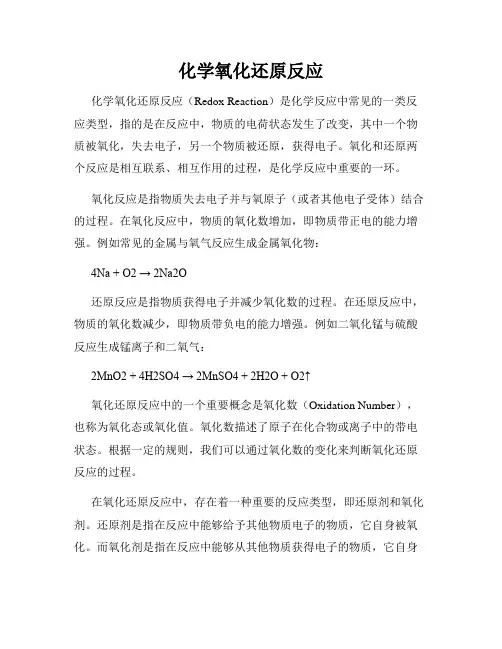
化学氧化还原反应化学氧化还原反应(Redox Reaction)是化学反应中常见的一类反应类型,指的是在反应中,物质的电荷状态发生了改变,其中一个物质被氧化,失去电子,另一个物质被还原,获得电子。
氧化和还原两个反应是相互联系、相互作用的过程,是化学反应中重要的一环。
氧化反应是指物质失去电子并与氧原子(或者其他电子受体)结合的过程。
在氧化反应中,物质的氧化数增加,即物质带正电的能力增强。
例如常见的金属与氧气反应生成金属氧化物:4Na + O2 → 2Na2O还原反应是指物质获得电子并减少氧化数的过程。
在还原反应中,物质的氧化数减少,即物质带负电的能力增强。
例如二氧化锰与硫酸反应生成锰离子和二氧气:2MnO2 + 4H2SO4 → 2MnSO4 + 2H2O + O2↑氧化还原反应中的一个重要概念是氧化数(Oxidation Number),也称为氧化态或氧化值。
氧化数描述了原子在化合物或离子中的带电状态。
根据一定的规则,我们可以通过氧化数的变化来判断氧化还原反应的过程。
在氧化还原反应中,存在着一种重要的反应类型,即还原剂和氧化剂。
还原剂是指在反应中能够给予其他物质电子的物质,它自身被氧化。
而氧化剂是指在反应中能够从其他物质获得电子的物质,它自身被还原。
例如在以下反应中,氧化剂是铁离子(Fe3+),而还原剂是锌金属(Zn):2Fe3+ + 2e- → 2Fe2+Zn → Zn2+ + 2e-氧化还原反应在生活中有着广泛的应用。
例如,腐蚀反应中物质与氧气的反应被视为氧化还原反应。
电池的工作原理也是基于氧化还原反应。
此外,许多化学合成、分解、电解以及生物学中的代谢过程都与氧化还原反应密切相关。
在实际的化学实验中,我们可以通过观察氧化还原反应的发生来判断反应是否进行。
常用的实验方法有观察气体生成、溶液颜色变化、固体物质颜色变化等。
同时,我们也可以通过平衡氧化还原反应方程式来计算物质的反应量,从而实现定量分析。

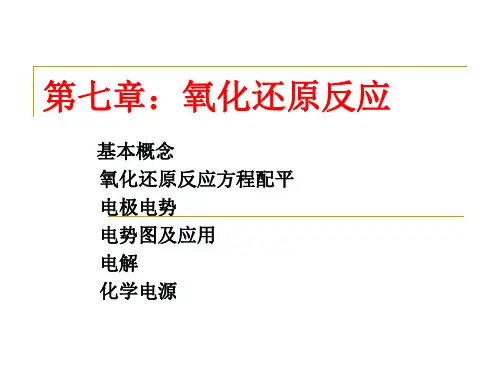
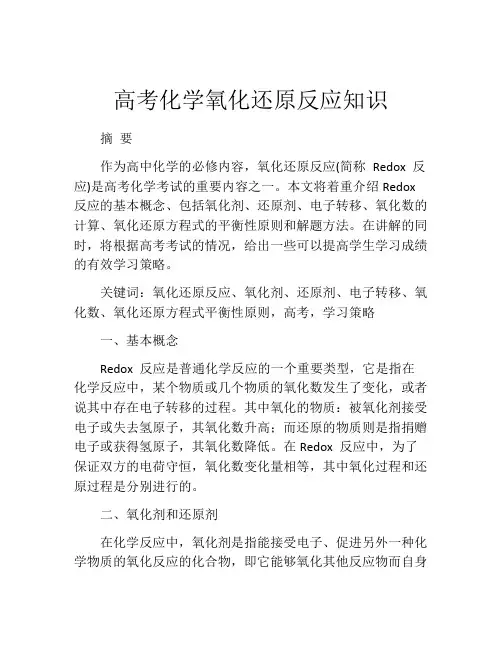
高考化学氧化还原反应知识摘要作为高中化学的必修内容,氧化还原反应(简称Redox 反应)是高考化学考试的重要内容之一。
本文将着重介绍Redox 反应的基本概念、包括氧化剂、还原剂、电子转移、氧化数的计算、氧化还原方程式的平衡性原则和解题方法。
在讲解的同时,将根据高考考试的情况,给出一些可以提高学生学习成绩的有效学习策略。
关键词:氧化还原反应、氧化剂、还原剂、电子转移、氧化数、氧化还原方程式平衡性原则,高考,学习策略一、基本概念Redox 反应是普通化学反应的一个重要类型,它是指在化学反应中,某个物质或几个物质的氧化数发生了变化,或者说其中存在电子转移的过程。
其中氧化的物质:被氧化剂接受电子或失去氢原子,其氧化数升高;而还原的物质则是指捐赠电子或获得氢原子,其氧化数降低。
在Redox 反应中,为了保证双方的电荷守恒,氧化数变化量相等,其中氧化过程和还原过程是分别进行的。
二、氧化剂和还原剂在化学反应中,氧化剂是指能接受电子、促进另外一种化学物质的氧化反应的化合物,即它能够氧化其他反应物而自身还原成较低的氧化态。
常见的氧化剂包括浓缩硫酸、氯气、高价的过渡金属离子等。
而还原剂则是指能够捐赠电子,促进另外一种化学物质的还原反应的化合物。
常见的还原剂包括铁,铝、摩根金属等。
氧化剂和还原剂是对应的,不能单独存在。
在化学反应中,当某个物质作为氧化剂时,另一个物质必然作为还原剂存在的。
三、电子转移Redox 反应中,随着化学反应的进行,原子中的电子云会发生移动,从而成为了电子的流动。
在Redox 反应中,电子的转移控制着反应的进行。
氧化剂从化学反应中接受电子而被还原;还原剂则是由于它失去了电子而被氧化。
举个例子,氯化铁溶液遇到铜粉时,会发生Redox反应:2 FeCl3(溶液)+ Cu(s) → CuCl2 + 2 FeCl2(溶液)在这个反应中,两个三价铁化合物被还原成了两个二价铁化合物,同时铜粉被氧化生成了二价的铜化合物。
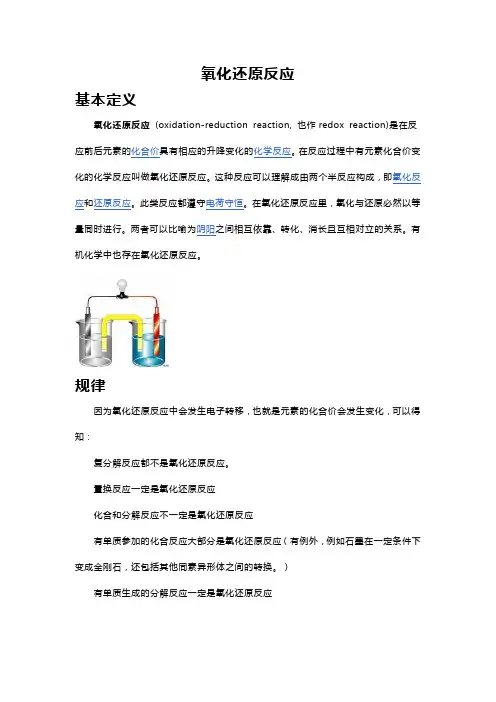
氧化还原反应基本定义氧化还原反应 (oxidation-reduction reaction, 也作redox reaction)是在反应前后元素的化合价具有相应的升降变化的化学反应。
在反应过程中有元素化合价变化的化学反应叫做氧化还原反应。
这种反应可以理解成由两个半反应构成,即氧化反应和还原反应。
此类反应都遵守电荷守恒。
在氧化还原反应里,氧化与还原必然以等量同时进行。
两者可以比喻为阴阳之间相互依靠、转化、消长且互相对立的关系。
有机化学中也存在氧化还原反应。
规律因为氧化还原反应中会发生电子转移,也就是元素的化合价会发生变化,可以得知:复分解反应都不是氧化还原反应。
置换反应一定是氧化还原反应化合和分解反应不一定是氧化还原反应有单质参加的化合反应大部分是氧化还原反应(有例外,例如石墨在一定条件下变成金刚石,还包括其他同素异形体之间的转换。
)有单质生成的分解反应一定是氧化还原反应对于不属于上述四种基本反应类型的化学反应,有属于氧化还原反应的(例如碳还原氧化铜),也有不属于氧化还原反应的(例如氧气在一定条件下反应变成臭氧)归中反应,歧化反应可以看作是特殊的氧化还原反应。
氧化反应:具有氧化性←氧化剂(反应物)—(失氧)→被还原→发生还原反应→化合价降低→得eˉ或共同电子对偏向→生成还原产物(具有还原性)还原反应:具有还原性←还原剂(反应物)—(得氧)→被氧化→发生氧化反应→化合价升高→失eˉ或共同电子对偏离→生成氧化产物(具有氧化性)当某元素为最高价次时,它只能做氧化剂。
当某元素为最低价次时,它只能做还原剂。
当某元素为中间价次时,它既能做氧化剂,又能做还原剂。
概念反应的本质是电子有转移(或电子偏移),其特征为化合价的升降。
化合价升高,即失电子的半反应是氧化反应;化合价降低,得电子的反应是还原反应。
化合价升高的物质还原对方,自身被氧化,因此叫还原剂,其产物叫氧化产物;化合价降低的物质氧化对方,自身被还原,因此叫氧化剂,其产物叫还原产物。

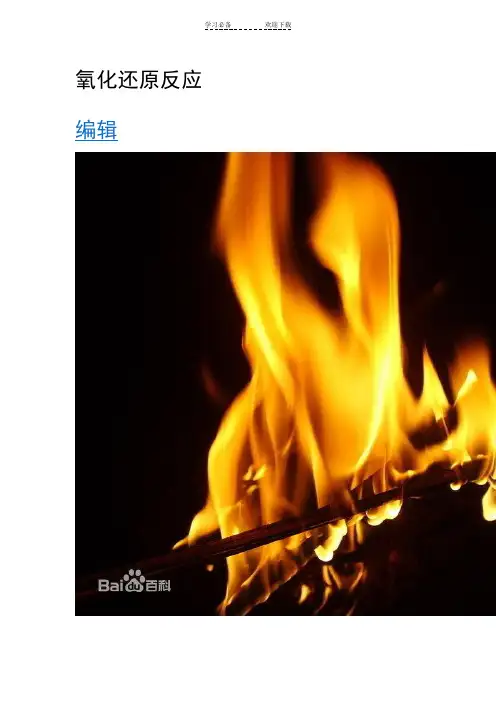
氧化还原反应编辑氧化-还原反应 (oxidation-reduction reaction, 也作redox reaction)是化学反应前后,元素的氧化数有变化的一类反应。
[1]氧化还原反应的实质是电子的得失或共用电子对的偏移。
氧化还原反应是化学反应中的三大基本反应之一(另外两个为(路易斯)酸碱反应与自由基反应)[2]。
自然界中的燃烧,呼吸作用,光合作用,生产生活中的化学电池,金属冶炼,火箭发射等等都与氧化还原反应息息相关。
研究氧化还原反应,对人类的进步具有极其重要的意义。
目录1理论发展2反应历程3氧化-还原平衡4判别5类型分子间分子内6规律7表示方法双线桥法单线桥法氧化-还原半反应式8举例燃烧酒精测试工业炼铁复分解反应9配平方法得失电子守恒法氧化数升降法离子/电子法待定系数法10应用与意义氧化还原性的强弱判定现实意义11与电化学的关系1理论发展18世纪末,化学家在总结许多物质与氧的反应后,发现这类反应具有一些相似特征,提出了氧化还原反应的概念:与氧化合的反应,称为氧化反应;从含氧化合物中夺取氧的反应,称为还原反应。
随着化学的发展,人们发现许多反应与经典定义上的氧化还原反应有类似特征,19世纪发展化合价的概念后,化合价升高的一类反应并入氧化反应,化合价降低的一类反应并入还原反应。
20世纪初,成键的电子理论被建立,于是又将失电子的半反应称为氧化反应,得电子的反应称为还原反应。
[2]1948年,在价键理论和电负性的基础上,氧化数的概念被提出,1970年IUPAC 对氧化数作出严格定义[1],氧化还原反应也得到了正式的定义:化学反应前后,元素的氧化数有变化的一类反应称作氧化还原反应。
注:氧化数又可以叫做氧化态,本词条使用前者。
氧化数即高中所说的化合价,这两者仅是叫法不同,部分表示方法有差别,其他并无区别,本词条中视为可以混用。
2反应历程氧化还原反应的实例——钠与氯气的反应[3]氧化还原反应前后,元素的氧化数发生变化。
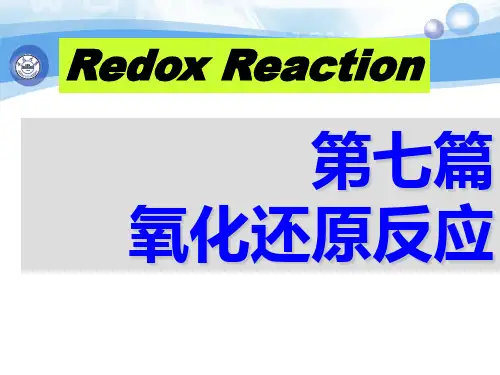
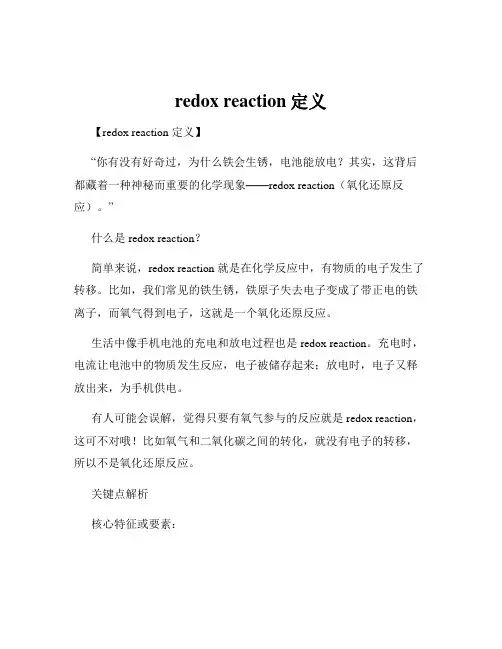
redox reaction定义【redox reaction 定义】“你有没有好奇过,为什么铁会生锈,电池能放电?其实,这背后都藏着一种神秘而重要的化学现象——redox reaction(氧化还原反应)。
”什么是 redox reaction?简单来说,redox reaction 就是在化学反应中,有物质的电子发生了转移。
比如,我们常见的铁生锈,铁原子失去电子变成了带正电的铁离子,而氧气得到电子,这就是一个氧化还原反应。
生活中像手机电池的充电和放电过程也是 redox reaction。
充电时,电流让电池中的物质发生反应,电子被储存起来;放电时,电子又释放出来,为手机供电。
有人可能会误解,觉得只要有氧气参与的反应就是 redox reaction,这可不对哦!比如氧气和二氧化碳之间的转化,就没有电子的转移,所以不是氧化还原反应。
关键点解析核心特征或要素:1. 电子转移:这是 redox reaction 的最关键特征。
就像买卖东西,电子从一个物质转移到另一个物质。
比如锌和硫酸铜的反应,锌原子失去电子变成锌离子,铜离子得到电子变成铜原子。
2. 化合价变化:参与反应的元素化合价会发生改变。
比如氢气和氧气反应生成水,氢元素从 0 价变成 +1 价,氧元素从 0 价变成 -2 价。
容易混淆的概念:氧化反应和还原反应常常让人混淆。
其实氧化反应是指物质失去电子的过程,而还原反应则是物质得到电子的过程。
它们是同时发生的,就像一个硬币的两面,缺一不可。
比如在氧化铜和氢气的反应中,氢气失去电子被氧化,氧化铜得到电子被还原。
起源与发展氧化还原反应的概念由来已久。
早在古代,人们就观察到了金属的腐蚀和燃烧等现象,但当时并不知道这背后的原理。
随着化学学科的发展,科学家们逐渐认识到电子转移在这些反应中的关键作用。
如今,氧化还原反应在各个领域都有着重要的作用。
在能源领域,燃料电池的工作原理就是基于 redox reaction,为我们提供清洁高效的能源。
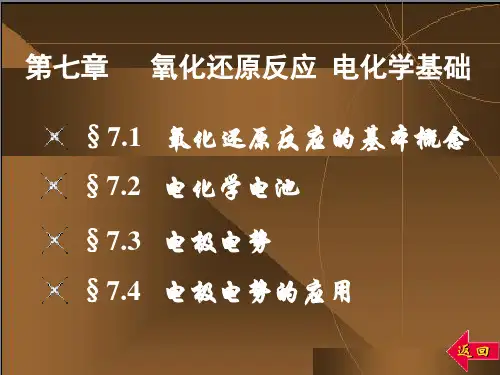
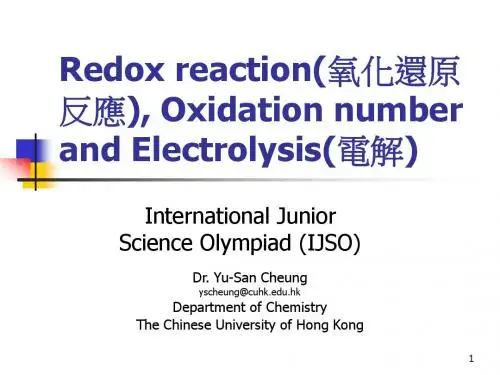
Chapter 7 Redox reaction7.1 What is redox reaction?There are two ways of finding out whether or not a substance has been oxidised or reduced during a chemical reaction:■■ electron transfer■■ changes in oxidation number.Oxidation is losing electrons. (OIL)Reduction is gaining electrons .(RIG)7.2 Redox and electron transferHalf-equationsExample: 2Na(s) + Cl2(g) →2NaCl(s)✓Na → Na++ e–Na – e– → Na+ Oxidation is losing electrons. (OIL)✓Cl2 + 2e– → 2Cl– Reduction is gaining electrons .(RIG)Balancing half-equationsExample : 1 Construct the balanced ionic equation for the reaction between nickel and iron(III) ions, Fe3+, from the half-equations:Ni(s) →Ni2+(aq) + 2e–Fe3+(aq) + e–→ Fe2+(aq)The balanced ionic equation is: ___________________________________________________Example : 2 Construct the balanced ionic equation for the reaction of iodide ions (I–) with manganate(VII) ions (MnO4–) inthe presence of hydrogen ions (H+). Use thefollowing two half-equations to help you:i 2I–(aq) →I2(aq) + 2e–ii MnO4–(aq) + 8H+(aq) + 5e–→ Mn2+(aq) + 4H2O(l)The balanced ionic equation is: ___________________________________________________Exercise : 2 a Write two half-equations for the following reactions. For each half-equation statewhether oxidation or reduction is occurring.i Cl2 + 2I– → I2 + 2Cl–ii 2Mg + O2→ 2MgOiii 4Fe + 3O2 → 2Fe2O3b Zinc metal reacts with IO3– ions in acidic solution.Construct a balanced ionic equation for thisreaction, using the two half-equations below:2IO3– + 12H+ + 10e– → I2 + 6H2OZn → Zn2+ + 2e–7.3 Oxidation numbersWhat are oxidation numbers(oxidation states)?Oxidising agent &reducing agentOxidation number rules1.单质化合价均为0.2.在化合物中,许多原子有固定化合价--第一主族(_________________________________________)元素为+1价--第二主族(_________________________________________)元素为+2价--氟元素(F)总为-1价--氢元素(H)为+1价(除非为金属氢化物,如NaH, H为-1 )--氧元素(O)为-2 价(过氧化物peroxide中的氧为-1,F2O中氧为+2)3. 化合物中各元素化合价之和为0.4. 离子团的化合价之和等于离子的带电荷数。
(如NO3- : N元素与O元素的化合价之和为-1)5. 无论是离子团还是化合物中,电负性更强的元素带负电。
Exercise :State the ox. no. of the bold atoms in these compounds or ions:a P2O5b S O42–c H2Sd Al2Cl6e N H3f Cl O2–g Ca C O37.4 Naming compoundOxides of nitrogen■■The ox. no. of N in N2O is +1. So this compound is nitrogen(I) oxide.■■The ox. no. of N in NO is +2. So this compound is nitrogen(II) oxide.■■The ox. no. of N in NO2 is +4. So this compound is nitrogen(IV) oxide.Nitrate ions■■ The ox. no. of N in the NO2– ion is +3. So NaNO2 is sodium nitrate(III).■■ The ox. no. of N in the NO3– ion is +5. So NaNO3 is sodium nitrate(V).7.5 From name to formulaExercise : Give the formulae of: a sodium chlorate(I) b iron(III) oxidec potassium nitrate(III)d phosphorus(III) chloride.7.6 Balancing chemical equations using oxidation numbersExample: Copper(II) oxide (CuO) reacts with ammonia (NH3) to form copper, nitrogen (N2) and water.Exercise: Use the oxidation number method to balance these equations.a H2SO4 + HI → S + I2 + H2Ob HBr + H2SO4→ Br2 + SO2 + H2Oc V3+ + I2 + H2O → VO2+ + I– + H+homeworkSection AQ2 A cheap carbon monoxide detector for a gas heater consists of a patch containing palladium chloride crystals. When carbon monoxide is present, the crystals turn from orange to black as the following reaction takes place.CO(g) + PdCl2(s) + H2O(l) → CO2(g) + Pd(s) + 2HCl(aq)orange blackWhich is the element whose oxidation number decreases in this reaction?A carbonB chlorineC hydrogenD palladiumQ4 The nickel-cadmium rechargeable battery is based upon the following overall reaction.Cd + 2NiOOH + 4H2O → Cd(OH)2 + 2Ni(OH)2.H2OWhat is the oxidation number of nickel at the beginning and at the end of the reaction?Q5 In the treatment of domestic water supplies, chlorine is added to the water to form chloric(I) acid, HClO.Cl2(aq) + H2O(I) → H+(aq) + Cl–(aq) + HClO(aq)This reacts further to give the chlorate(I) ion.HClO(aq) + H2O(I) → H3O+(aq) + ClO–(aq)Both HClO and ClO– kill bacteria by oxidation.What is the change in oxidation number of chlorine in forming the chlorate(I) ion from the aqueous chlorine?A –1B 0C +1D +2Q6 Ammonium nitrate, NH4NO3, can decompose explosively when heated.NH4NO3 → N2O + 2H2OWhat are the changes in the oxidation numbers of the two nitrogen atoms in NH 4NO 3 when this reaction proceeds?A –2, –4B +2, +6C +4, –6D +4, –4 Q8 In which substance does nitrogen exhibit the highest oxidation state?A NOB N 2OC N 2O 4D NaNO 2 Q11 Chlorine dioxide is produced on a large scale as it is used for bleaching paper pulp. It is made by the following reaction.2Cl O 3(aq) + SO 2(g) → 2Cl O 2(g) + SO 4 (aq)How do the oxidation numbers of chlorine and sulphur change in this reaction?Q12 In some early paintings, lead(II) carbonate was used as a white pigment. In the 19th century hydrogen sulphide from burning coal reacted with this pigment to form black lead(II) sulphide, PbS. The original colour of the painting may be restored by carefully treating the area with dilute hydrogen peroxide, producing lead(II) sulphate which is also white. What is the role of the hydrogen peroxide?A catalystB oxidising agentC reducing agentD solvent Q13 In an experiment, 50.0 cm 3 of a 0.10 mol dm –3 solution of a metallic salt reacted exactly with 25.0 cm 3 of 0.10 mol dm –3 aqueous sodium sulphite.The half-equation for oxidation of sulphite ion is shown below.SO 3 (aq) +H 2O(I)→SO 4 (aq) +2H (aq) +2e If the original oxidation number of the metal in the salt was +3, what would be the new oxidation number of the metal? A+1 B+2 C+4 D+5 Q14 The amount of titanium dioxide in an ore can be determined by using the following reaction. 3TiO2 + 4BrF3 → 3TiF4 + 2Br2 + 3O2Which element increases in oxidation number in this reaction?A bromineB fluorineC oxygenD titaniumQ16 Sodium iodide reacts with concentrated sulfuric acid. The equation which represents one of the reactions that takes place is shown.8NaI + 9H2SO4 → 8NaHSO4 + 4I2 + H2S + 4H2OWhich species has been oxidised in this reaction?A H+B I–C Na+D SO42–Q17 In which reaction does an element undergo the largest change in oxidation state?Q19 Which conversion involves a reduction of chromium?Section BQ20 Many crude oils contain sulphur as H2S. During refining, by the Claus process, the H2S is converted into solid sulphur, which is then removed.reaction I 2H2S(g) + 3O2(g) → 2H2O(l) + 2SO2(g)reaction II 2H2S(g) + SO2(g) → 2H2O(l) + 3S(s)Which statements about the Claus process are correct?1 H2S is oxidised in reaction I.2 SO2 oxidises H2S in reaction II.3 SO2 behaves as a catalyst.Q21 Which reactions are redox reactions?1 CaBr2 + 2H2SO4→ CaSO4 + Br2 + SO2 + 2H2O2 CaBr2 + 2H3PO4 → Ca(H2PO4)2 + 2HBr3 CaBr2 + 2AgNO3 → Ca(NO3)2 + 2AgBrQ22 Zirconium, Zr, proton number 40, is a metal which is used in corrosion-resistant alloys. Zirconium metal is extracted from the oxide ZrO2 by the following sequence of reactions.reaction1 ZrO2+2Cl2+2C→ ZrCl4+2COreaction 2 ZrCl 4 + 2Mg→ Zr + 2MgCl 2Which statements about this extraction process are correct?1 Carbon in reaction 1 behaves as a reducing agent.2 Magnesium in reaction 2 behaves as a reducing agent.3 Chlorine in reaction 1 behaves as a reducing agent.Q2 Magnesium burns in nitrogen to give magnesium nitride, a yellow solid which has theformula Mg3N 2.Magnesium nitride reacts with water to give ammonia and magnesium hydroxide.(i)Construct an equation for the reaction of magnesium nitride with water. ................................................................................................................................................. (ii)Does a redox reaction occur when magnesium nitride reacts with water?Use the oxidation numbers of nitrogen to explain your answer. ....................................................................................................................................................... ....................................................................................................................................................... ....................................................................................................................................................... ................................................................................................................................. (June 2009) Acidified potassium dichromate(VI) can oxidise ethanedioic acid, H2C2O4.The relevant half-equations are shown.Cr2O72– + 14H+ + 6e–→ 2Cr3+ + 7H2OH2C2O4→ 2CO2 + 2H+ + 2e–(a) State the overall equation for the reaction between acidified dichromate(VI) ions and ethanedioic acid. (2)(b) In an experiment a 0.242 g sample of hydrated ethanedioic acid, H2C2O4.x H2O, was reacted with a 0.0200 mol dm–3 solution of acidified potassium dichromate(VI).32.0 cm3 of the acidified potassium dichromate(VI) solution was required for complete oxidation of the ethanedioic acid.(i) Calculate the amount, in moles, of dichromate(VI) ions used to react with the sample of ethanedioic acid.amount = ............................. mol [1] (ii) Calculate the amount, in moles, of ethanedioic acid in the sample.amount = ............................. mol [1] (iii) Calculate the relative molecular mass, M r, of the hydrated ethanedioic acid.M r = (1)(iv) Calculate the value of x in H2C2O4.x H2O.x = (1)[Total: 6] 3. A 6.30 g sample of hydrated ethanedioic acid, H2C2O4.x H2O, was dissolved in water andthesolution made up to 250 cm3.A 25.0 cm3 sample of this solution was acidified and titrated with 0.100 mol dm–3 potassium manganate(VII) solution. 20.0 cm3 of this potassium manganate(VII) solution was required to react fully with the ethanedioate ions, C2O42–, present in the sample.(a) The MnO4– ions in the potassium manganate(VII) oxidise the ethanedioate ions.(i) Explain, in terms of electron transfer, the meaning of the term oxidise in the sentence above. ............................................................................................................................................. (1)(ii) Complete and balance the ionic equation for the reaction between the manganate(VII) ions and the ethanedioate ions.2MnO4–(aq) + 5C2O42–(aq) + .........H+(aq) .........(aq) + 10CO2(aq) + .........H2O(l)[3] (b) (i) Calculate the number of moles of manganate(VII) used in the titration.[1] (ii) Use the equation in (a)(ii) and your answer to (b)(i) to calculate the number of moles ofC2O42– present in the 25.0 cm3 sample of solution used.[1] (iii) Calculate the number of moles of H2C2O4.x H2O in 6.30 g of the compound.[1] (iv) Calculate the relative formula mass of H2C2O4.x H2O.[1] (v) The relative formula mass of anhydrous ethanedioic acid, H2C2O4, is 90.Calculate the value of x in H2C2O4.x H2O.[1] [Total: 9]。